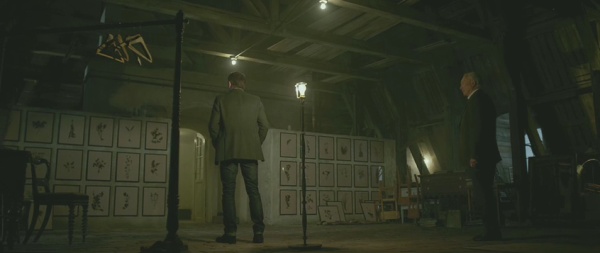2012 // USA - UK // Christopher Nolan // July 27, 2012 // Digital Theatrical Projection (Wehrenberg Des Peres 14 Cine)
The third (and by all accounts final) of director Christopher Nolan's Batman films pulls off a rather curious feat, one that appears to be novel in the annals of sequel-dom. The Dark Knight Rises manages to enrich the series as a whole, even as its only intermittently successful tonal and thematic preoccupations throw the singular achievements of its direct forebear, The Dark Knight, into sharper relief. To be sure, Rises is pleasingly effective as a sequel, and it carries the ashen aura of its predecessors to appropriately dizzying heights (and depths). The film expands upon the convoluted narrative and absorbing themes presented in the first two films, wrapping up Nolan's grim, mayhem-and-exposition-stuffed trilogy in a quite gratifying manner. Appraised as three chapters in a sprawling seven-plus-hour tale, the Batman films take on an air of queasy grandeur. Together, they comprise an unsettling epic about paralyzing contemporary fears, moral codes both noble and demented, and cramped psyches straining against the fragility of flesh and spirit. Rises also returns the focus to the fundamental story at the saga's heart: that of a haunted vigilante and the city he has taken as his personal charge. In this, Rises resembles Batman Begins a bit more than The Dark Knight. Its primary absorptions are the psychological contours of Bruce Wayne and the phenomenon of the Caped Crusader. Nolan's Batman films, especially Begins, have often observed that the cowl itself is a potent symbol. Rises clarifies and complicates this observation, presenting it as a quandary rather than a strength. The Batman is now bigger than Bruce, and it will outlast him. The fresh conflict posed by Rises is: Can Bruce disentangle himself from this symbol before he makes his exit? And does he even want to?
Unfortunately, restoring the centrality of Bruce Wayne has the effect of rendering Rises a bit more personal and corralled than the blissfully out-of-control The Dark Knight. Admittedly, this is an odd complaint to direct at Rises, a film that features several outlandishly super-villainous plots, not to mention the subjugation of all of central Gotham City under a nuclear-backed, months-long Reign of Terror. However, the first-order appeal of 2008's The Dark Knight is one of mood, a mood established through a brilliant intersection of velocity, atmosphere, and performance. There is something wickedly phosphorescent about Nolan's second Batman film. Its vision of a world gone mad possesses a noxious clarity, assisted in no small part by Heath Ledger's still-mesmerizing portrayal of the Joker. The Dark Knight offers an essential portrait of early twenty-first-century American fear, and its Gotham is partly a “Nightmare Town” plucked from Frank Miller's demented headspace and partly a crumbling Ground Zero where an alien malevolence writes its rambling manifesto in napalm. Perhaps it's unfair to gripe that Rises returns the focus of the story to the character of Bruce Wayne; narratively speaking, such realignment is arguably the sensible and humane thing to do in a Batman trilogy. However, the third film unquestionably feels a bit diminished and even prosaic in the enervating, reflected light of The Dark Knight.
Summarizing the story of Rises in great detail seems patently unnecessary. Suffice to say that it is eight years after the events of the prior film, and Bruce Wayne (Christian Bale) is now a stiff-jointed recluse, having hung up his cowl and permitted the Batman to be vilified as a murderer. Commissioner Gordon (Gary Oldman) is nearing retirement, the city's prisons are swelling with convicts, and crime is at an all-time low. Of course, this last fact doesn't appear to account for the nocturnal prowlings of cat burglar Selina Kyle (Anne Hathaway), who has set her sights on the baubles of Gotham's One Percent. The threat that is foremost on Bruce's mind, however, is a masked fiend known as Bane (Tom Hardy), a mysterious soldier-of-fortune who has purportedly arrived in Gotham in order to carry out a violent revolution. That upheaval gives lip service to the miseries endured by the roused rabble, but it is directed by Bane's glib cynicism and sociopathic personality. Similar to those of the Joker, Bane's plots are massive, staggeringly crabbed things, demanding a level of planning that strains against the supposed realism of Nolan's series. However, where the Joker veered from one unlikely scheme to the next “like a dog chasing a car,” Bane moves calmly and relentlessly towards a singular goal: the obliteration of Gotham and the Batman, in that order. This establishes Bane as a more opposable and comprehensible nemesis, in that he has a Master Plan that must be discerned and stopped. The question becomes whether the weaker, slower, out-of-practice Bruce is capable of stopping Bane. The horror of Rises is therefore not one of "escalation," as foreshadowed in Begins and demonstrated in The Dark Knight, but of diminishment, of the unstoppable march towards a day when the Batman will be defeated.
Rises develops this thematic thread splendidly, although the film surrounds it with obscurely presented plot points, questionable character actions, and a plethora of science-fiction nonsense that far outdoes anything in the prior films. (In one of the film's more laughable sights, an enormous fusion reactor-turned-doomsday device is tossed around as though it were a medicine ball, with no discernible effect on its ominous countdown.) One wonders why Nolan elected to resurrect the unfortunate Bond-villain wackiness of Begins—recall Ra's al Ghul's ludicrous “microwave water vaporizer” scheme—and meld it with the often confounding, Byzantine plotting of The Dark Knight. Regardless, Rises' story is at its most enthralling when it is focused on Bruce Wayne and his demons, rather than militaristic spectacle. Certainly, there's an adolescent thrill to be gleaned from the sight of Batman's hovercraft dodging heat-seeking missiles between Gotham's skyscrapers, or of thousands of police officers and Bane-loyal zealots clashing man-to-man in the streets within a haze of swirling snow. What truly lingers, however, is the stark drama of Bruce's tribulations in a hellish prison-pit half a world away. Echoing motifs and moments stretching all the way back to the opening scenes of Begins, it is this borderline surreal sequence that exhibits Nolan at his most evocative and persuasive. The sequence cunningly exploits both Bruce Wayne's status as a legendary hero and the thematic groundwork laid by the prior films, creating an emotional crescendo that matches the guttural chant of the prisoners: “Rise... Rise... Rise...”









